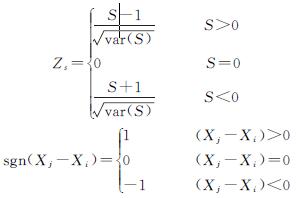资助项目:甘肃农业大学科技创新基金“盛彤笙创新基金:SWAT模型在祁连山小流域的径流模拟研究”(GSAU-STS-2018-35)
第一作者:秦格霞(1995—),女,甘肃宁县人,在读硕士,研究方向为生态遥感。E-mail:2603246958@qq.com 通信作者:芦倩(1986—),女,甘肃永登人,讲师,在读博士,研究方向为GIS应用与森林水文。E-mail:lq04500232@qq.com
(1.甘肃农业大学 资源与环境学院, 兰州 730070; 2.西安东方宏业科技有限公司,西安 710000; 3.苏州科技大学 机械工程学院, 江苏 苏州 215009)
(1.College of Resources and Environmental Sciences, Gansu Agricultural University, Lanzhou 730070, China; 2.Xi'an Dongfanghongye Technology Co., Ltd, Xi'an 710000, China; 3.School of Mechanical Engineering, Suzhou University of Science and Technology, Suzhou, Jiangsu 215009, China)
dynamics of NDVI; grassland; spatial heterogeneity; climate change
了解草地覆盖动态在生态环境保护和建设上有重要意义。基于GIMMS NDVI3g数据、气象数据和高程数据分析了1982—2015年中国北方草地NDVI时空动态及对气候变化的响应。结果 表明:(1)1982—2015年中国北方草地NDVI以增加趋势为主(占76%),增速为0.002/10 a。其中,坡地草地的增加速率最大(增长速率为0.001/10 a),高山亚高山平原草原变化速率最小,其他4种草地类型速率为平原草地NDVI增长速率>高山亚高山草甸>荒漠草原>草甸;(2)NDVI变异系数均值为0.078,变化相对稳定(Cv<0.15);(3)Hurst指数均值为0.42,结合NDVI变化趋势结果发现未来草地NDVI变化趋势主要以下降为主(0<H<0.5,占79.8%);(4)降水是影响北方草地生长的主要气候因子。除昆仑山脉、青海高原东坡坡底及小兴安岭等海拔较高区域外,其他地区(占92.4%)的降水与NDVI呈显著相关关系。温度与草地NDVI主要以正相关为主(占62.7%),呈负相关关系的区域集中在内蒙古高原、黄土高原西南部、准噶尔盆地和塔里木盆地等较为干旱地区。以上研究结果可为草地资源管理、生态环境保护、荒漠化防治提供重要参考信息。
Understanding the spatial-temporal changes of grassland is of great significance to regional environmental protection and ecological construction. The spatial-temporal variation characteristics of grassland was analyzed based on the GIMMS NDVI 3g data, meteorological data and DEM data for northern China during the period 1982 to 2015. The results indicate that:(1)NDVI mainly showed growth trend from 1982 to 2015, with growth rates of 0.000 2/decade(76%); the growth rate of slope grassland was the(0.001/10 a), the growth rates of alpine and sub-alpine plain grassland were the smallest, and the growth rates of the NDVI of the other four grassland types decreased in the order: plain grassland>alpine subalpine meadow >desert grassland>meadow;(2)the average coefficient of variation of grassland NDVI was 0.078, with the stable state(Cv<0.15);(3)the average Hurst value was 0.42; according to the coupling results of NDVI and Hurst index, it is found that the future NDVI change trend of the grassland will mainly reduce(0<H<0.5, accounting for 79.8%);(4)precipitation was the main factor for grassland growth in northwest China except for higher latitudes; In snow-covered areas, 92.4% of the precipitation was favorable for NDVI growth except Kunlun Mountains, the bottom of the eastern slope of the Qinghai Plateau temperature and the Iljehari-Alin, precipitation in other areas and NDVI had positive correlation; the NDVI of grassland was mainly positive correlation(62.7%)with temperature, and the negative correlation areas concentrated in Inner Mongolia Plateau, the southwest of Loess Plateau, Junggar Basin and Tarim Basin. The above results are expected to provide important reference information for grassland resource management, ecological environment protection and desertification control.
草地生态系统作为陆地生态系统中的敏感成员[1],在发展畜牧业[1-2]、维持生物多样性[2]、维持生态系统平衡等[2-3]方面发挥着重要作用,但其发育与演替受气候、人类活动等影响较为严重[3-9]。据气象报告显示过去几十年间气候经历了明显变化[10],这势必会对我国(尤其在干旱半干旱地区)草地生长产生显著影响[4-9],进而影响全球的物质循环和能量流动,对生态系统的稳定性产生重要影响。归一化植被指数(NDVI)作为植物生长状况及地表覆盖变化的最佳指示因子[8,11],已被广泛用于研究陆地生态系统植被长势[8]、季相[8]、物候等[12]变化趋势中,是研究植被变化和植被—气候关系的首选指标[4-12]。
近年来,国内外诸多学者基于NDVI指数研究了植被随气候波动的变化情况,取得了卓越成果[13-21]。如:梁爽等[21]利用AVHRR NDVI数据研究我国草地生长时空变化发现,在1982—2010年草地NDVI呈增加趋势,但1999年以后大范围出现逆转,尤以干旱、半干旱地区最为显著; 而尼加提·伊米尔等[20]基于MODIS NDVI数据研究发现因全球气候变暖,2000—2015年天山山区降水量增加,导致天山北坡NDVI呈增加趋势; 但戴声配等[22]基于SPOT-NDVI对祁连山植被时空动态研究发现,自1999年以来,祁连山植被NDVI呈减少趋势的多集中在河流等较为湿润的区域; 赵鸿雁等[13]研究2008—2016年甘肃中东部的NDVI变化发现,低山丘陵区与冲积平原区生长季NDVI明显增加,部分中起伏山地出现减少的现象,但以2012年为一个突显的转折点; 阿荣等[11]研究了2000—2015年锡林郭勒草地生长季NDVI变化得出每年以0.002 1的速率缓慢增长,但其变化存在明显地域差异,降水是影响锡林郭勒地区NDVI动态变化的主要因素。正如上述综述所示,虽有很多学者对植被覆盖动态及其对气候变化的响应做了大量工作,但因研究数据、研究区、植被类型和起始年份不同而存在差异。草地植被覆盖研究作为草地生态系统动态监测的一项长期性、经常性的工作,被列为生态保护与修复工程的重要任务之一。因此,引入NDVI探究在生态保护与修复工程措施下草地覆盖动态及其对气候变化的响应情况,从而掌握和评价生态保护与修复等工程的所取得的效果有重大意义[14,16,23]。
基于此,本文利用长时间序列(1982—2015年)的GIMMS NDVI数据,辅以Sen+Mann-Kendall(M-K)、变异系数Cv,Hurst指数等方法对1982—2015年我国北方天然草地NDVI时空变化、变化的稳定性和未来变化趋势进行分析。并结合草地类型分类数据分析不同草地覆盖下NDVI变化特征,以掌握退耕还林还草等生态工程措施下草地NDVI的时空变化特征,以期为我国生态环境改善、畜牧业管理措施及未来生态环境建设提供科学依据。
研究区为我国北方草地覆盖区域(32°—53°N,77°—135°E),总面积为1.559×106 km2(图1)[1,24]。区域所处纬度较高,草地面积较大,距海较远,西、北边沿有山脉阻隔,大部分区域属温带大陆性干旱气候,是非季风气候影响的主要地区,少部分属寒温带季风气候和高原高山气候。光热资源充足,年日照时数达2 200 h以上,降水量少而不匀,一般多在400~800 mm,主要集中在7月、8月,春冬季节旱情严重,夏秋多暴雨,多大风天气[24]。因其特殊的地理位置、地形条件和干旱气候的影响,区域内生态环境极为脆弱,草地类型主要以温性草原、荒漠草原、高寒草甸、高寒草原、盐生草甸为主,温性草原面积最大,是我国天然草地的主体,是欧亚草原的重要组成部分[24]。
气象(气温、降水)数据由中国气象数据网站(http:∥data.cma.cn/data/cdcdetail/dataCode)提供,选用剔除有数据缺失的站点后,选取了324个气象站点的1982—2015年气温、降水的月数据(图2)。数字高程模型(DEM)来源于地理空间数据云的SRTM产品数据,分辨率为30 m。并采用基于样条函数插值理论的专业气象插值软件ANUSPLINE[25],以DEM数据为协变量,对气温和降水数据进行空间插值获得8 km的栅格数据。最后选用计算中未使用的气象站点,随机选取417个数据对插值结果进行精度验证,结果表明气温插值数据与实测值的相关系数基本在在0.975以上(占97.5%),均方根误差(RMSE)=0.000 08。而降水与插值结果的相关系数基本在0.918以上,均方根误差(RMSE)=0.000 11,插值精度在整体上可以满足研究的需求。
NDVI数据来自西部环境与生态科学数据下载中心(https:∥ecocast.arc.nasa.gov/data/)提供的1982—2015年15 d最大值合成的8 km的GIMMS NDVI3g数据集(版本3)。该数据是由NOAA卫星搭载的AVHRR传感器获取,经过校正,最大程度减少火山气溶胶、太阳高度角、传感器误差和偏移影响的全球植被数据[12,21],但仍存在假高值、低值。为减少云、大气等造成的假高值、低值影响,将多时相NDVI组合为时间序列,提取每个像素时序值,基于Savitzky-Golay(S-G)滤波法拟合[26],拟合前后数据的平均绝对误差(MAE)=0.000 5,均方根误差(RMSE)=0.001 9,相关系数在0.90以上的像元占总像元的96.3%,仅在祁连山脉、甘肃陇南有较少像元相关系数在0.70~0.80[12],整体保真性较好。并采用国际上常用的NDVI(年均值)=0.05排除非植被因素影响[12],为了与气象数据保持一致,采用最大值合成法获得月NDVI数据。
草地类型数据由国家自然科学基金委员会"中国西部环境与生态科学数据中心"(http:∥westdc.westgis.ac.cn)提供的空间分辨率为l km的GLC 2000数据集,采用FAO的土地覆盖分类标准(LCCS),通过非监督分类方法制作的全球土地覆盖图[27]。高艳妮等[28]对我国北方地区的土地分类数据(30 m地表覆盖数据、1:10万中国草地资源图、中国土地利用现状遥感监测数据、中国土地覆盖数据、全球陆地覆盖数据、全球土地覆盖数据和MODIS土地覆盖数据)进行精度评价发现GLC 2000的其采样点验证精度为83.45%,精度排在第三,与1:10万中国草地资源图在面积上一致性最高。在该分类系统中,草地类型包括草甸、平原草地、荒漠草原、坡地草地、高山亚高山草甸、高山亚高山平原草原(图1)[27]。
(1)空间趋势分析采用非参数趋势度Sen[28]分析法分析1982—2015年我国北方草地NDVI变化趋势,并基于Mann-Kendall(M-K)[29]统计检验法对趋势的显著性进行检验。Sen趋势分析法和M-K检验法相结合,可减少数据异常值的影响,几乎不受测量误差和离群数据的干扰[29]。计算公式为:

式中:SNDVI为NDVI变化趋势; i,j(1982≤i<j≤2015)为NDVI的时间序数; NDVIi,NDVIj分别表示第i,j对应的NDVI值。当SNDVI>0时,说明NDVI呈增长趋势; SNDVI<0,NDVI呈下降趋势。
M-K检验公式[30]为:
S=∑n-1i=1∑nj=i+1sign(NDVIj-NDVIi)
其中:

其中:

式中:S为检验统计量; Zs为标准化后的检验统计量; n为NDVI的总序列数; var(S)为方差。给定的显著性水平α下,当|Zs|>Z(1-)/2时,表示变化趋势显著。结合SNDVI值和|Zs|值,将草地趋势变化的显著性分为6个等级,即在大于等于1.615,1.943,2.518时,分别表示通过了置信度90%,95%,99%的显著性检验(不显著增加/减少、显著增加/减少、极显著增加/减少)[29]。
(2)稳定性分析利用变异系数Cv来表示草地NDVI相对波动程度,数值越大表明草地受干扰强度越大,越不稳定; 数值越小说明植被状态相对稳定[28]。计算公式如下:

式中:Cv为NDVI变异系数; NDVIi表示第i年对应的NDVI值; NDVImean为基于1982—2015年的NDVI数据获得的多年NDVI均值。
(3)未来趋势分析Hurst指数是根据NDVI时间序列数据预测未来NDVI的变化趋势,是一种定量表述时间序列信息长期依赖性的有效方法[31]。本文用来研究草地NDVI未来的趋势,其计算原理可参考相关研究[31],Hurst指数分为3种情况:若0≤Hurst<0.5,说明NDVI时序数据具有长期的相关性,将来的总体趋势和过去的趋势相反,时间序列表现出反持续性; 所Hurst=0.5,表明NDVI时序数据互相独立且没有依赖性,现在不会影响未来; 0.5<Hurst≤1,表明未来的NDVI时序数据总体趋势与过去的总体趋势相同,过程具有持续性,越接近1,持续性越强[31]。
(4)月均NDVI与月均气温、降水的偏相关性分析地理系统是由多因素组成的复杂系统,采用偏相关分析法逐像元分析北方草地月均NDVI和月均气温、月均降水因果关系,公式如下[28]:

式中:x表示NDVI; y代表月均降水; z为月均气温; rxy表示月均NDVI与月均降水的相关系数; rxz表示月均NDVI与月均气温的相关系数; ryz表示月均降水与月均气温的相关系数。rxy·(z)为变量降水固定后月均NDVI与月均气温的偏相关系数,以此类推。
使用均值法计算得到的34 a间中国北方草地NDVI的时间特征(图2)发现:中国北方NDVI以0.000 2/10 a的速率增加(p<0.05),变化相对稳定,NDVI值基本在0.2附近上下波动,2008年NDVI有最大值。但不同的草地类型NDVI变化特征各不相同,坡地草地NDVI >草甸>高山亚高山草甸>平原草地>高山亚高山平原草原>荒漠草原NDVI。其中,坡地草地的增加速率最大(增长速率=0.001 82/10 a,相关系数=0.811),变化较为明显; 高山亚高山平原草原变化速率最小,其他4种草地类型速率从大到小为平原草地NDVI增长速率>高山亚高山草甸>荒漠草原>草甸。总体来看,2007—2008年,2008—2009年的两个期间NDVI先剧增后剧减,为34 a间变化较为明显的两个阶段。
基于均值法计算得到34 a间中国北方草地NDVI的空间分布情况(图3),发现NDVI<0.1的地区集中在地处西北的昆龙山脉和阿尔金山脉周围,NDVI>0.5主要分布在祁连山脉北坡,天山山脉(主要集中在南坡)和小兴安岭地区。NDVI值的分布整体呈现出从东南向西北逐渐降低。
结合草地类型图(图1A)可知:草甸、平原草地类型的NDVI基本在0.3以上,南北分布差异较小; 荒漠草地的NDVI值基本在0.3以下,但存在明显区域差异,如在新疆、青海的荒漠草地比在内蒙古地区的NDVI低; 坡地草地、高山亚高山草甸、高山亚高山平原草原的NDVI基本在0.3以上,但高山亚高山草甸的NDVI存在明显的南高北低的特征。
基于Sen和M-K检验方法得到34 a间NDVI变化趋势的空间分、全部草地和每种草地在不同变化等级中所占面积(图4),发现我国北方地区NDVI以增加趋势为主,占研究区总面积的76%。其中,极显著增加所占比例最大(占43%),集中分布在黄土高原、青海高原、祁连山脉地区。NDVI呈减少趋势集中分布在大兴安岭、小兴安岭和天山山脉地区,以不显著减少为主(占18%)。增加趋势的面积比例远高于减少趋势,表明研究区草地覆盖状态整体上为不断改善趋势。
就每种草地类型而言,6种草地类型的NDVI值呈增加趋势的面积均高于呈减少趋势面积,坡地草地类型表现为增加趋势的比例最大(占98%),其次为荒漠草原(占76%),再次为平原草地(占74%),草甸呈增加趋势的比例最小(占59%),高山亚高山草甸、高山亚高山平原草原增加趋势所占比例分别为72%和68%。
基于中国北方草地34 a间各像元的NDVI变异性计算结果和实际情况,将变异划分为8个等级(图5)。中国北方草地34 a间NDVI变异系数的平均值为0.078,变化相对稳定(<0.15),但这种稳定性存在显著的空间差异。低波动(0~0.1)约占31.4%,其中,较低波动变化(0.1~0.15)占53.6%,主要分布在除祁连山脉、青海高原和大、小兴安岭区域、昆仑山脉外的其他区域。区域内较高波动变化(0.15~0.2)和高波动变化(>0.2)仅占整个研究区的15.0%,集中新疆的尔齐斯河、伊犁河、塔里木河、塔里木盆地和甘肃境内的黄河流域以及内蒙古的呼伦贝尔高原呼伦湖周围,这些区域大部分为河流和沙漠地区。
草地类型除高山亚高山草甸和荒漠草原呈高波动的面积达到8%,其他4种草地类型呈高波动所占面积不足5%。其中,稳定性最好的草地类型为草甸,其次为高山亚高山平原草原; 稳定性最差的为荒漠草原,其次为高山亚高山草甸。
基于1982—2015年中国北方草地NDVI的Hurst指数(H)分布图(图6),发现中国北方草地未来变化趋势具有Hurst现象,Hurst指数均值为0.42,即未来一段时期内草地NDVI的变化趋势与1982—2015年的变化趋势整体表现为相反趋势。H介于0~0.5的面积占79.8%。结合前面的NDVI变化趋势发现我国北方地区草地NDVI在未来一段时间内会出现大面积的减少趋势。其中,反持续性极显著减少(0≤H<0.2)占0.6%,零星的分布在青海高原区域; 反持续性显著减少(0.2≤H<0.4)占35.1%,主要集中在内蒙古高原、青海高原、阿尔卑斯山脉和天山山脉; 44.0%的区域为反持续性减少不显著(0.4≤H<0.5),零散分布在整个研究区。未来草地NDVI的变化趋势与1982—2015年的变化趋势相同的面积(0.5<H≤1)的仅占研究区总面积的15.7%,远小于反持续性变化,主要分布在黄土高原和小兴安岭区域内。未来NDVI变化趋势表现为随机的面积(H=0.5)占研究区总面积的4.5%,零星分布在昆仑山脉、青海高原和祁连山脉。
从草地类型的统计数据(图6)发现:每种草地均以反持续性变化为主,除坡地草原外,其他几种草地类型基本占到每种草地类型总面积的80%左右; 持随机变化趋势区域约占每种草地类型总面积的2%; 与现在变化趋势一致的仅占不到18%(除坡地草原)。
中国北方草地NDVI与气温和降水的关系图(图7A,7B)中显示,1985—1987年、1989—1991年、1993—1995年、1997—1999年、2001年、2003年、2005—2006年、2012年中国北方草地NDVI与气温的年际变化趋势上表现出一致性,其余大部分时段与NDVI的变化趋势相反。草地NDVI与降水的年际变化趋势总体上具有同步性,但1982—1984年、1989—1992年、2003年、2005年表现出相反的变化趋势。
从北方草地NDVI与气温和降水的偏相关关系图中(图7C,7D),发现在控制降水的条件下NDVI和气温之间的关系为正负相关并存,但只有0.7%的区域达到p<0.05的显著性检验; 其中,37.3%的区域呈正相关关系(即气温升高对草地生长是有利的),主要集中在内蒙古高原、青海高原及甘肃境内黄河流域等海拔较高、较低周围及冰雪覆盖区域。相关系数集中在0~-0.3之间所占面积最大,大部分区域气温升高对草地的生长是有利的; NDVI与气温之间呈负相关的区域主要分布于内蒙古高原、黄土高原西南部、准噶尔盆地和塔里木盆地等较为干旱地区,年均气温升高对草地的生长是不利的。NDVI与降水之间也呈现正负相关并存的特征,但正相关(92.4%)约是呈负相关(7.6%)的9倍,只有3.5%的区域达到p<0.05的显著性检验; 年降水量的增多对草地植被的生长不利的区域多集中在昆仑山脉、青海高原东坡坡底和小兴安岭零散分布。
草地对地形地貌、气候变化和人类活动的响应过程是一个复杂的动态过程。不同地貌条件会导致热量和水分的空间差异,进而使得不同地区、不同草地类型NDVI存在明显空间差异,尤其在对气温和降水敏感的干旱、半干旱地区尤为显著[13-22]。我国西北地区大面积处于干旱、半干旱地区,降水量的多少直接影响草地的生长状况。本文通过研究1982—2015年我国草地时空特征变化及其对气候变化的响应,发现除昆仑山脉、青海高原东坡坡底和小兴安岭等海拔较高的区域外(图7B),NDVI随降水量的增加而增加。而温度对海拔较高地区的草地生长是有利的,但在较为干旱的地区(如黄土高原西南部、准噶尔盆地和塔里木盆地),温度升高对草地的生长是不利的。这主要是因为温度过高会导致植被叶片蒸腾作用加快,导致蒸散发增加,使得土壤水分减少,反过来抑制植被生长和光合作用; 而降雨量会直接影响土壤含水量,同样会加速植物内部化学反应速度。太阳辐射较好的阳坡由于降雨量较少会容易导致更多的蒸散发,使植被覆盖度降低,阴坡主要由于光照和太阳辐射较差,容易形成干冷的天气,不利于植被生长[32-36]。
除气候因素等自然因素外,人类行为也是影响草地NDVI动态的一个重要原因。已有学者研究表明大型的生态工程会对植被等的生长产生正面的影响[13,16,23,34],如1999年、2003年开始实施的退耕还林还草、退牧还草以及2008年土地整治相关措施的实施,对我过草地植被产生了较为显著的影响。如梁爽等[21]研究发现在1982—1999年全国草地生长季NDVI的变化较为显著,但是从1999年之后,因实施的一些生态工程项目的原因,草地NDVI的变化趋势和方向与研究时段有关。修丽娜等[16]人对1990—2015年黄土高原土地利用类型转移数据进行统计发现,1990—2000年,草地大量转为耕地和人工表面(转化面积分别为4 104.05 km2,270.87 km2),其原因主要是因为这一时期我国人口大量增加,黄土高原的开荒力度加大,很多天然草地覆盖区被人类所占用; 而2000—2015年,草地面积约增加了14 278.59 km2,这主要是因为退耕还林(草)生态工程的实施,坡度较大的耕地转换为草地。以上这些都为本文的研究结果的正确性提供了支持(2007—2009年的NDVI呈现出显著的相反变化趋势,其中坡地草地和草地变化最为显著)。但也有研究[37]表明因退耕还林还草政策实施后,没有考虑到地区的气候、水文等自然因素,林地面积的大幅度增加会使土壤蒸发量加大,从而造成土地的干旱程度增加,对草地生造成了影响,草地NDVI降低。因此,进行大规模的植树造林还草等工程可能存在风险。因此,大型生态工程实施的后期是否会有片面(或负反馈作用)影响还需进一步研究。再者,在未来的生态环境保护上是否应该考虑将将改变现有的土地覆盖类型转移为重点的工程,转为禁止放牧、过度开垦等以制约人类活动方面,值得研究人员和相关工作人员关注。
虽目前对植被NDVI的变化趋势、影响因子的研究较多,且大多数结果都表明在近30 a的我国很多地区NDVI都表现出增加趋势[13,15,20-21,32],本文研究结果与已有的结果空间和时间变化趋势具有一致性。但是,目前对未来植被NDVI的变化趋势的研究较少,且研究结果上存在差异性。如:李双双等[33]对陕甘宁地区的植被未来趋势研究发现研究区大部分植被薄覆盖变化将持续改善; 但赵安周[34]、孙锐[35]、刘宪锋[36]等分别对黄土高原和秦巴山区的植被未来变化趋势研究发现,大部分区域植被未来的变化趋势与现在的变化趋势相反,可能在将来植被会呈现退化的趋势,这与本文的研究结果较为一致。但未来NDVI的趋势研究因为受到很多自然和认为的因素,因此,研究人员应持续关注退化地区的植被状态。
(1)北方草地NDVI以增加趋势为主(占76%),其增速为0.002/10 a,但存在西北低、东南部高的分布特征,其中1999年和2008年为突变点。
(2)山地草原类型表现为增加趋势的比例最大(98%),其次为荒漠草原(76%),再次为坡地草地(74%),草甸呈增加趋势的比例最小(59%),高山亚高山草甸、高山亚高山平原草原增加趋势所占比例分别为72%和68%。
(3)34 a间NDVI变异系数的平均值为0.078,变化相对稳定(<0.15),但这种稳定性存在显著的空间差异性。
(4)Hurst指数均值为0.42,未来草地NDVI变化趋势与现在变化趋势呈反持续性变化的面积(0<H<0.5)占总面积的79.8%; 草地NDVI变化趋势延续现在植被变化态势区域(0.5<H≤1)占总研究区的15.7%。变化随机的(H=0.5)面积占4.5%。
(5)降水是西北草地生长的主要因素,除纬度较高的冰雪覆盖区,92.4%地区的降水对NDVI生长是有利的; 除较干旱地区外,气温升对NDVI生长呈不显著的正相关(37.3%)。